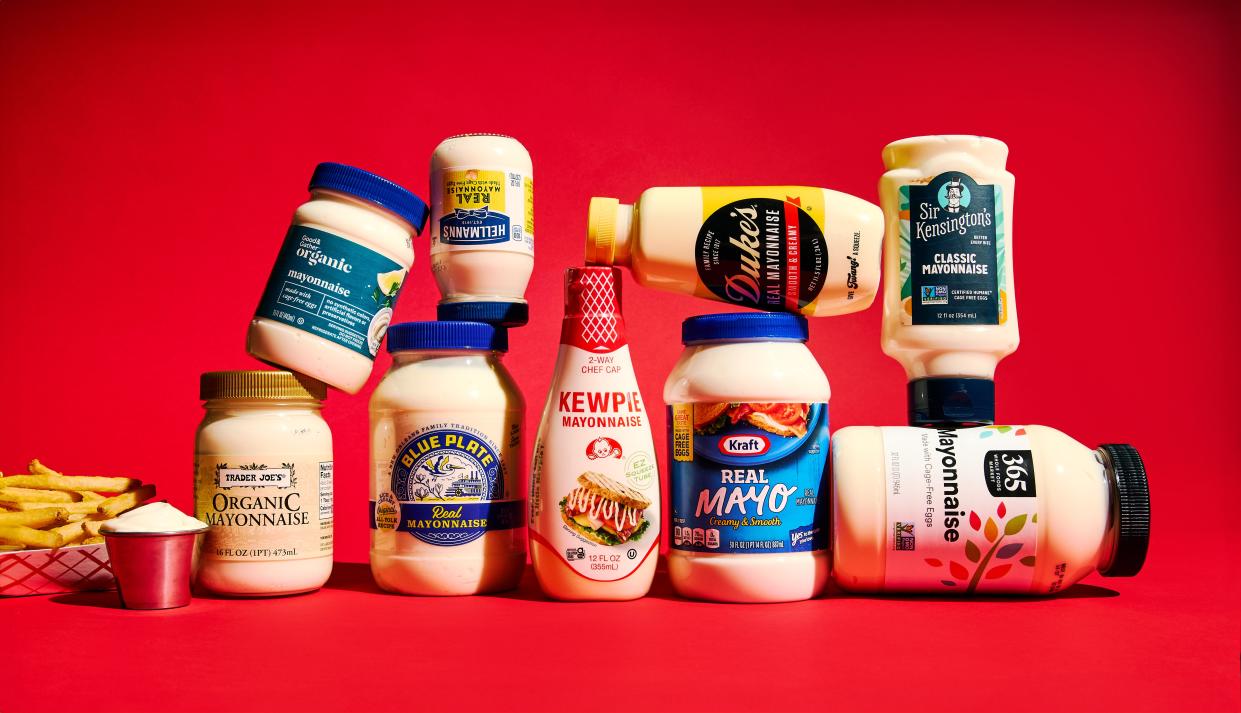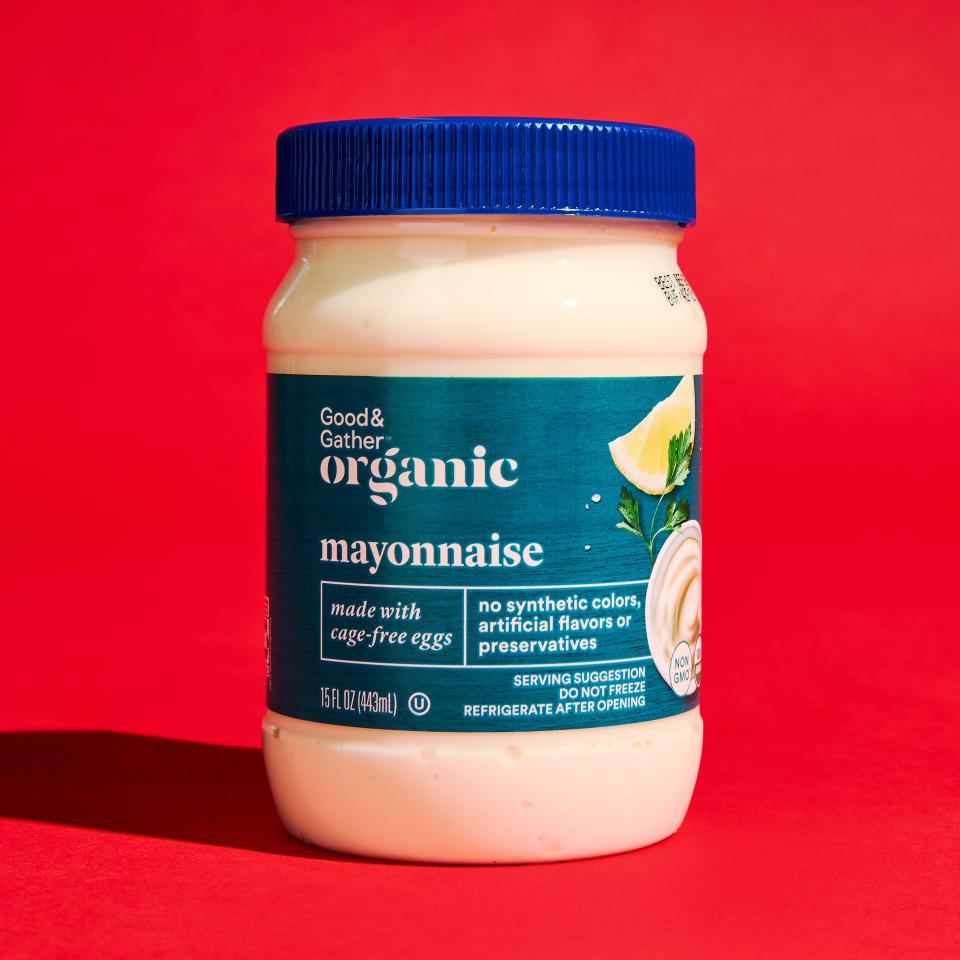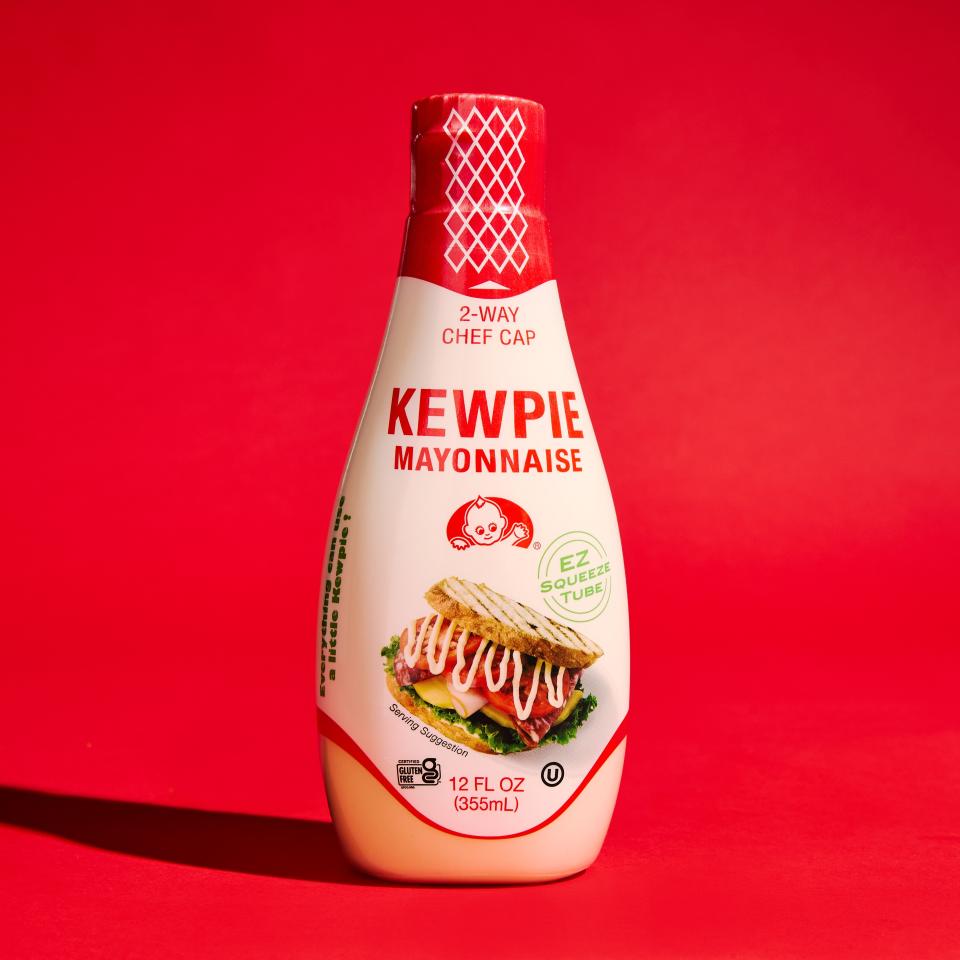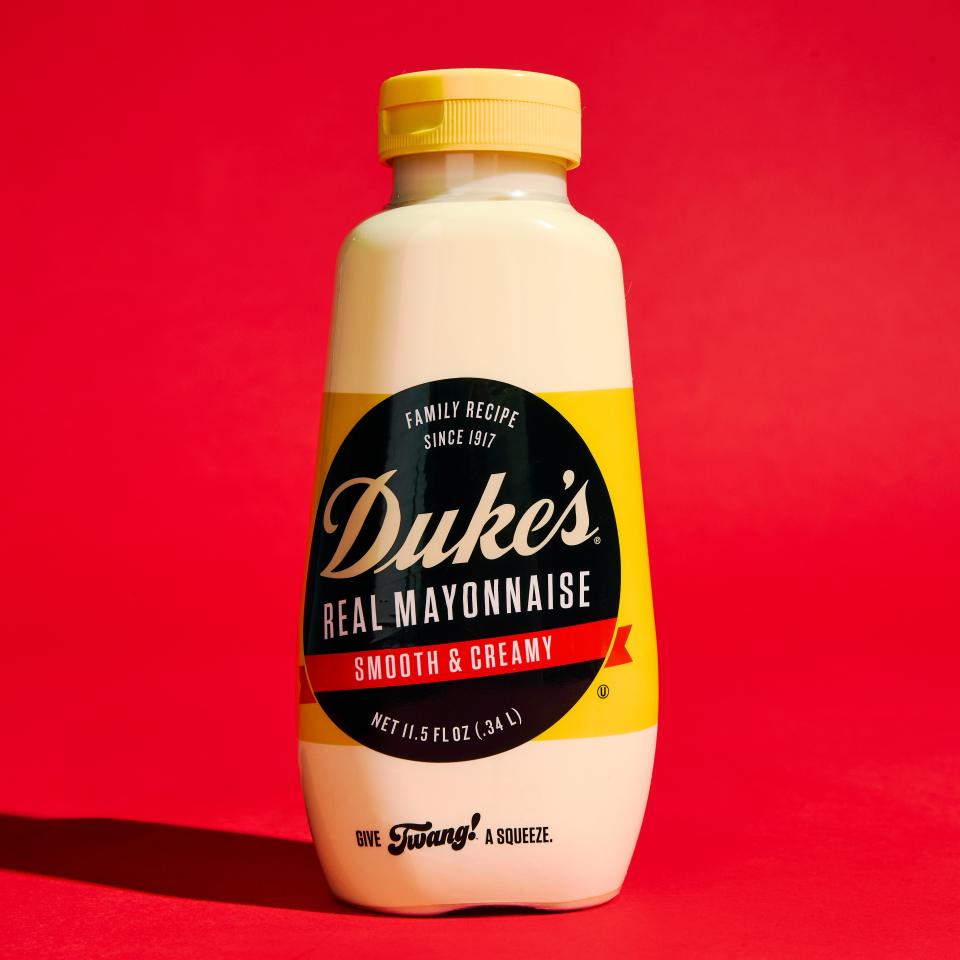Which Mayonnaise Is Best? A Taste Test of Duke’s, Kewpie, and More

Photograph by Andre Rucker, Food Styling by Emilie Fosnocht
In our Taste Test series, BA editors conduct blind comparisons to discover the best supermarket staples (like hot dogs or vanilla ice cream). Today, we dive in to figure out which mayonnaise you should grab off the shelf.
Your choice of mayonnaise is highly personal. Perhaps you’re devoted to Hellmann’s after a childhood spent swiping it onto tomato sandwiches every summer. Maybe a spiritual awakening in your 20s left you steadfastly committed to Kewpie. Whichever mayo team you’re on, there’s simply no substitute for its creamy twang in your patty melt or for its moist richness in a chocolate cake.
While not impossible, making mayonnaise at home is a delicate process. You have to coax water and oil, two substances famous for not getting along, into an emulsion. That’s accomplished with the help of raw eggs, the yolks of which contain a group of phospholipids called lecithin, which coats tiny droplets of fat from the oil and bonds it to the water. Traditional methods have you delicately trickle in a stream of oil with one hand as you furiously whisk with the other—not an easy task since too much oil too fast results in a broken oily mess. Thankfully, immersion blenders exist, and using one to mix up mayonnaise is pretty difficult to mess up.
While we can’t imagine anything better than handmade mayonnaise for an ambitious Grand Aioli, when we’re whipping up a quick work-from-home lunch, it’s store-bought all the way. To find the absolute best mayonnaise, our staff gathered in the test kitchen for what may have been our most opinionated taste test yet.
How we set up our blind taste test
Nobody should have to eat plain mayonnaise—let alone nine plain mayonnaises. It’s a fate we wouldn’t wish on our worst enemy. Instead, we heated up french fries and tater tots in the oven, and used those as crispy vessels. We plopped (and swirled and swooshed—we can’t help it) each mayonnaise onto a plate, then hid the container so its brand was unknown to the tasters. Then, once our discerning staffers gathered round in the test kitchen, we gave each mayo several tastes—no double-dipping—to get a clear picture of its texture and flavor. Finally, we eliminated our definite passes and narrowed down the standouts.
How we picked the products
We wanted to test mayonnaise in its purest form. To us, that meant that we wouldn’t include variations like light mayo, any made with alternative oils (like olive or avocado), or vegan versions. Miracle Whip, which, per USDA guidelines, can’t even call itself mayonnaise because of its lower oil content, also didn’t make the cut.
After determining what we didn’t want, we settled on what we did. As for all of our taste tests, we compiled popular supermarket brands by touring the internet—scouring some opinionated Reddit threads and asking our editors to name their favorites. Our final list included nine brands of mayonnaise, some of which were supermarket white labels and others that were well-known condiment brands.
We’d be lying if we said that our tasters went in with no biases. Restaurant editor Elazar Sontag swears by mayo stalwart Hellmann’s, while director of creative development Ian Stroud was quick to declare that his go-to is Kewpie. But the blind taste test format means your faves may flop—and when our test concluded, our winning brands were revealed to gasps and pearl clutches all around.
How our editors evaluated
We eat with our eyes, as the saying goes, and that’s how we started our mayonnaise taste test. Some of our entries were ghostly white, while others were closer to cream or ecru. Some were tinged with yellow. To us, mayo’s color isn’t as valuable as its flavor, but tasters agreed that a bright, celebrity-veneer white wasn’t entirely appealing.
Our tasters also judged on texture. Some of the brands of mayo were airy and gelatinous, jiggling on their plates. Others were looser and creamier, like sour cream. Our panel agreed that a wiggling mayonnaise was not ideal. We’re looking for a creamy and spreadable consistency, not unlike Greek yogurt.
Finally, we judged on flavor—the most important factor for our taste test. A great mayonnaise, our tasters said, should balance its fatty richness and cheeky tang with the slightest hint of sweetness. It should have a solid base of umami without an overwhelming taste of egg, and a good hit of acid—be it lemon or vinegar—for balance.
With some enticing-looking candidates in front of us, we charged ahead, tots in hand, and didn’t stop until we found our three favorites.
The Heavy Hitter: Good & Gather Organic Mayonnaise

Taste Test: Mayonnaise Bon Appetit
Photograph by Andre Rucker, Food Styling by Emilie FosnochtTarget’s store brand, Good & Gather, frequently places well in our taste tests, so it wasn’t surprising to see that its organic mayonnaise was a winner. It uses soybean oil, a common base oil in commercial mayonnaise, and organic egg yolks, as well as distilled vinegar, cane sugar, mustard seed, lemon juice concentrate, and “natural flavors.” Mayonnaise can be made with a whole egg, or just the yolk, but since the egg white is mostly made of water, you’re not missing much in a mayonnaise made without it.
Why it won us over: We talk a lot about balance in our taste tests, but there’s something to be said for a mayonnaise that boasts an explosion of every flavor. Good & Gather’s mayo has a lot of character: tons of umami, a big slice of citric acidity, and a wink of sweetness, all of which play together well. Elazar thought the oil content felt “right” and called it “assertive.” Associate director of cooking Emma Laperruque noted the big hits of acidity and savory flavor. “I would dip a lot in that,” said senior visuals editor Megan Paetzhold.
We’d love it in: Throw Good & Gather mayo in a punchy ranch dressing (even one with jalapeño), turn it into a sauce for these crunchy coconut shrimp, or indulge its main character syndrome with this vegetarian Italian hoagie.
The Umami Unicorn: Kewpie Mayonnaise

Taste Test: Mayonnaise Bon Appetit
Photograph by Andre RuckerBeloved by our staff for years, this Japanese brand stands out in large part due to its formula. Its ingredients listed on our bottle included egg yolks as well as red wine vinegar, rice wine vinegar. While the version sold in Japan includes MSG, Kewpie on American shelves swaps it out for “yeast extracts,” which are a source of naturally occurring glutamates—a cousin of MSG, monosodium glutamate. Those glutamates are responsible for a big hit of umami. Kewpie notably uses more egg yolks than many other mayonnaises—four in every bottle—which gives a big boost to the savory richness of the final product. Plus, it comes in a squeeze bottle, which is just plain fun.
Why it won us over: It’s hard not to notice Kewpie’s distinctly sunny color, our tasters said. It was the yellowest mayonnaise our tasters tried, and its swooping smooth texture was a good sign from the jump. Ian called it “appropriately complex,” and Megan said it was “a happy mayo.” And who doesn’t want to be happy? Tasters loved its bright vinegar zing up front, which backed off into a lovely rounded eggy umami. It struck the perfect balance between savory and sweet, or as a smiling Elazar exclaimed: “That’s the best of both worlds!”
We’d love it in: This is a mayo for sauces and dips, though, it will stand out just about anywhere. Try it in this Spicy Salmon Roll Bowl (with life-changing chili crisp mayo), or Jackson Pollock–ed over okonomiyaki. It would also excel in this classic tuna melt or squiggled on a five-minute turkey sando before you dash out the door.
The All-Around Favorite: Duke’s Real Mayonnaise

Taste Test: Mayonnaise Bon Appetit
Photograph by Andre RuckerDuke’s mayonnaise has a lot of fans, and many of them feel passionately about their favorite mayo—passionately enough to get it tattooed on their bodies, even. The ingredients list doesn’t hold many surprises: soybean oil, eggs, and water. The main seasoning is paprika, and the acidity comes from cider vinegar, a departure from the plainer distilled vinegar in most brands of mayonnaise. And Duke’s notably skips sugar (which appears in many mayonnaise brands, including both Good & Gather and Kewpie).
Why it won us over: In its marketing materials, Duke’s talks a big game about its “twang,” and that’s just what our panel enjoyed. Elazar described it as a “classic mayo taste”—not too eggy, not sweet, and with just the right amount of acidity. The custard-colored swirls were quickly swiped through with fry after fry as our tasters piled on compliments. “Just the right balance,” Ian said. “The color is really nice,” Megan added enthusiastically. You would have thought they were trying to get this mayonnaise to cosign a loan the way they were talking about it. Even Elazar, a longtime Hellmann’s devotee, ended up picking Duke’s as his favorite.
We’d love it in: a bowl for dipping fries, chips, and anything we can get our hands on. It would also soar in potato salad, tuna salad, egg salad, you get the idea. Or dollop it on a jammy egg, put it toward crisp-tender asparagus, turn it into a white sauce for halal cart chicken—we could go on.
We also tried…
Trader Joe’s: We like tang but not this much tang. Our tasters found it “distracting” and “unbalanced.” (For boxed brownies, though, Trader Joe is your guy.)
Kraft: The best Ian could muster for this one is that it was “inoffensive,” while Emma said it was far too sweet.
Hellmann’s: A mayo power player, but in our blind tasting, even the Hellmann’s stans on staff didn’t get much flavor. “I can’t taste it,” Emma said, brow furrowed as she bit into her second mayo-dunked fry.
Sir Kensington’s: There’s a lot of controversy here around a perceived formulation change that we can neither confirm nor deny. What we can say is that a recently purchased jar was not our cup of tea. Elazar called it “pungent” and “eggy.”
Blue Plate: Texture isn’t everything, but it is something, and Blue Plate didn’t hit the mark. It was firmly in jiggle territory, like the texture of cottage cheese. (Not that we don’t love cottage cheese—we do.)
Whole Foods 365: Our tasters got a strong fishy taste here, akin to anchovies, which wasn’t what we were after for an all-purpose mayonnaise.
Originally Appeared on Bon Appétit
More Cooking Stories From Bon Appétit
Get Bon Appétit in your inbox with our daily newsletter.
The Bon Appétit 56—our recipe shortlist for 2024—is here. Which dish will you make first?
Check out what our editors are cooking and baking at home.
Hard ciders have gotten seriously good—these are our favorites.
What to do with leftover broccoli stems? Make these two-ingredient pickles.
Chris Morocco solves your kitchen emergencies on our podcast Dinner SOS.
Cook all the Bon Appétit recipes you love with our Epicurious app.


